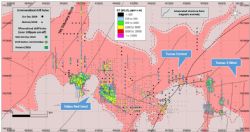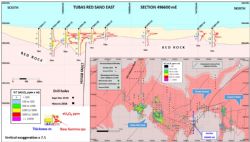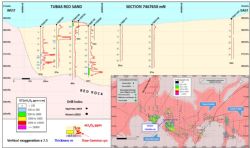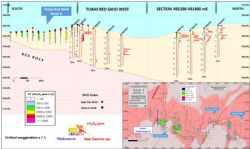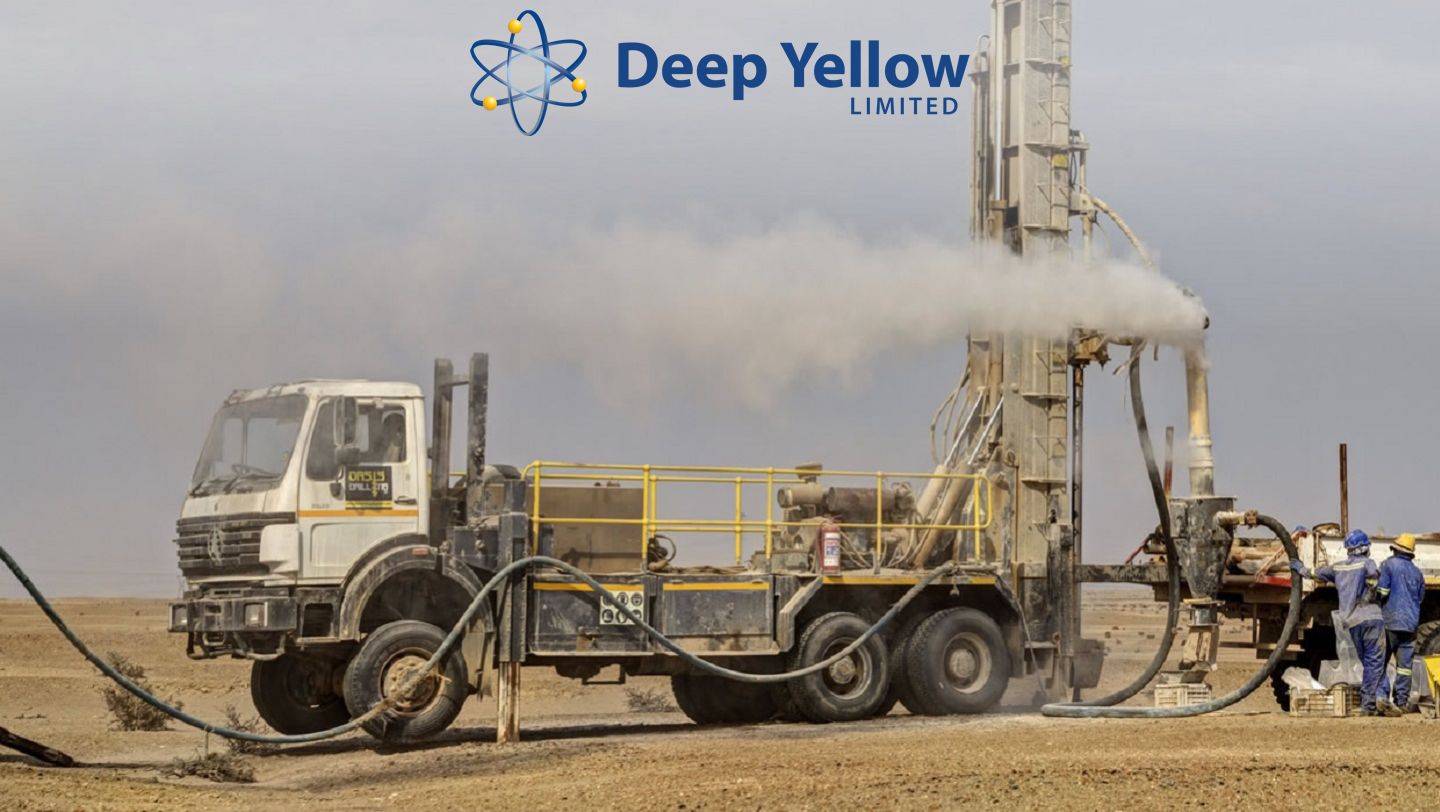
Positive Results Continue from the Tumas Palaeochannel
Perth, Dec 16, 2019 AEST (ABN Newswire) - Deep Yellow Limited ( ASX:DYL) (
ASX:DYL) ( JMI:FRA) (
JMI:FRA) ( DYLLF:OTCMKTS) is pleased to advise that the exploration drilling program in the Tubas Red Sand and Tubas Calcrete area has been completed. Exploration drilling continued from 14 October west of the Tumas Central area along the main Tumas paleochannel on EPL 3496. Exploration drilling aimed at, and succeeded, in outlining additional calcrete-type uranium mineralisation below the surficial Red Sand deposit.
DYLLF:OTCMKTS) is pleased to advise that the exploration drilling program in the Tubas Red Sand and Tubas Calcrete area has been completed. Exploration drilling continued from 14 October west of the Tumas Central area along the main Tumas paleochannel on EPL 3496. Exploration drilling aimed at, and succeeded, in outlining additional calcrete-type uranium mineralisation below the surficial Red Sand deposit.
Importantly, drilling has also delineated new zones for future resource in-fill drilling within this part of the main Tumas channel. EPL 3496 is held by Reptile Uranium Namibia (Pty) Ltd (RUN), a member of the group of companies wholly owned by Deep Yellow.
Exploration drilling has now been shut down for the Christmas break and will resume in late January 2020.
Commenting on the continued exploration success, John Borshoff Managing Director/CEO said: "It is highly encouraging that the latest exploration results which has extended testing to the west continues to produce positive results delineating further uranium mineralisation. The Tumas palaeochannel is proving to be a highly prospective target with significant upside.
"There is a strong expectation that Tumas will reward the Company with additional uranium resources, as we continue to evaluate and test the remaining 55km of the channel system.
"Importantly, our Namibian project portfolio continues to grow as we focus on advancing our dual-pillar growth strategy."
As advised in the 21 October announcement, the 2019 drilling program at Tumas 3 West and Central was completed and exploration drilling commenced advancing west into the Tubas Red Sand and Calcrete areas. The program which has yet to be completed comprised of 147 RC holes for 3938m (see Figure 1*) before shutting down for the break.
Concurrently diamond core drilling to obtain samples for metallurgical testing started at Tumas 3. As of 12 December, a total of 21 holes for 416m have been completed.
2 RC holes for 50m were drilled to twin two selected DDH holes to obtain additional material for testing.
Tubas Red Sand and Calcrete RC Drilling
The exploration drilling conducted west of Tumas Central was carried out on drill spacings varying from 100m to 200m along lines 200m to 400m apart. Drilling covered various zones interpreted to be prospective for calcrete-type mineralisation occurring below the near-surface (zero to 10m) Red Sand deposits.
Drilling has been successful in identifying three areas for future in-fill resource drilling. The mineralisation was found at depths between 1m to 40m below surface. In the exploration drilling area, uranium mineralisation >100ppm/m eU3O8 was identified in 75 (51%) of the 147 holes drilled in this zone. At >200ppm/m cut-off, the average grade returned is 335ppm eU3O8.
The Red Sand deposits are exposed in parts of the area where they show pronounced radiometric anomalism.
Drill hole locations from this program are shown in Figure 2*.
Figures 3, 4 and 5* show drill cross-sections indicating the continuity and variable depth of the mineralisation. Each of these areas are will be subject to follow-up work.
The equivalent uranium values are based on down-hole radiometric gamma logging carried out by a fully calibrated Aus-Log gamma logging system.
Mineralised RC hole intersections above the 100ppm eU3O8 over 1m cut-off are tabulated in Table 1, Appendix *1. All RC drill hole locations are listed in Table 2, Appendix 1*.
Tumas 3 DDH Drilling
The diamond core drilling at Tumas 3 is focused on obtaining near to 1,000kg of mineralised material suitable for metallurgical test work. Thus far, a total of 21 holes for 416m have been completed in 2019. A further 200m are planned to be drilled in January to March 2020 to complete this program.
The drill core obtained from this work will be used to refine the geological model and obtain approximately 500 density determinations to be used in future resource estimations to upgrade to Indicated and Measured JORC reporting status.
To date, mineralised intersections totalling approximately 600kg have been collected and are now sealed and packed for transport to Australia. In addition, 2 RC holes for 50m were drilled to twin two selected DDH holes to obtain additional material for testing and comparative analysis.
The DDH drill hole locations are listed in Table 3 of Appendix 1*.
Analysis
The results of the ongoing exploration drilling program continue to define additional zones of uranium mineralisation and continue to reinforce the highly encouraging prospectivity of the palaeochannels associated with the Tumas palaeochannel.
The exploration drilling programs at the Tumas palaeochannel now include testing of the Tubas Red Sand and Calcrete area and importantly, succeeded in extending the previous depth limits of the known mineralisation of the palaeochannel in this area.
Drilling has also identified the potential to further extend the mineralisation in this channel to the west and along other parts of the palaeochannel system including tributary channels.
Drilling results have also continued to confirm that uranium mineralisation is not confined to one single channel but rather is associated with a complex palaeodrainage system containing numerous channels and tributaries.
Conclusion
The first 8,026m drilled between August and December 2019 of the 23,000m expanded RC drilling program for FY20 has produced successful results.
65% of overall drilling planned for FY20 has yet to be carried out. This drilling will recommence in late January 2020. Importantly, ongoing drilling is confirming that previously discovered deposits can be expanded upon, providing significant potential upside to add to the current uranium resource base of the project.
Five distinct mineralised zones (Tumas 1 & 2, Tumas 3, Tubas Red Sand/Calcrete deposits and Tumas 1 East) within 70km of the 125km of palaeochannels have now been identified within the Reptile Project tenements (see Figure 1*).
Only 56% of the 125km of the targeted channels have been sufficiently explored over the past three years and, to date, the Inferred uranium resource base in the Tumas channel system has been increased by 280% from 32.2Mlb U3O8 at 252ppm to 92.5Mlb U3O8 at 277ppm.
Some 44%, or approximately 55km, of this palaeochannel system which deepens to the west remains to be properly tested.
The ongoing positive results from the current 2019/20 drill program continue-on from the previous 2018 and 2017 successful drill programs. Drilling remains focussed, guided by the breakthrough re-interpretation of historic exploration data which defined the regional palaeochannel target. All work is confirming the Company's confidence that the existing uranium resource base for Langer Heinrich-style deposits within the Reptile Project area has strong potential to be further increased.
The Company plans to continue this successful drilling program throughout the first half of 2020 commencing in late January. Initially, the drilling will focus on resource infill drilling to upgrade parts of Tumas 3 to the Indicated Mineral Resource JORC reporting category, followed by resource drilling at Tumas Central and Tubas Red Sand areas to enable an updated Mineral Resource Estimate to be completed for these parts of the paleochannel.
*To view tables and figures, please visit:
https://abnnewswire.net/lnk/278ZK537
About Deep Yellow Limited
 Deep Yellow Limited (ASX:DYL) (OTCMKTS:DYLLF) is successfully progressing a dual-pillar growth strategy to establish a globally diversified, Tier-1 uranium company to produce 10+Mlb p.a.
Deep Yellow Limited (ASX:DYL) (OTCMKTS:DYLLF) is successfully progressing a dual-pillar growth strategy to establish a globally diversified, Tier-1 uranium company to produce 10+Mlb p.a.
The Company's portfolio contains the largest uranium resource base of any ASX-listed company and its projects provide geographic and development diversity. Deep Yellow is the only ASX company with two advanced projects - flagship Tumas, Namibia (Final Investment Decision expected in 1H/CY24) and MRP, Western Australia (advancing through revised DFS), both located in Tier-1 uranium jurisdictions.
Deep Yellow is well-positioned for further growth through development of its highly prospective exploration portfolio - ARP, Northern Territory and Omahola, Namibia with ongoing M&A focused on high-quality assets should opportunities arise that best fit the Company's strategy.
Led by a best-in-class team, who are proven uranium mine builders and operators, the Company is advancing its growth strategy at a time when the need for nuclear energy is becoming the only viable option in the mid-to-long term to provide baseload power supply and achieve zero emission targets.
Importantly, Deep Yellow is on track to becoming a reliable and long-term uranium producer, able to provide production optionality, security of supply and geographic diversity.
| ||
|



